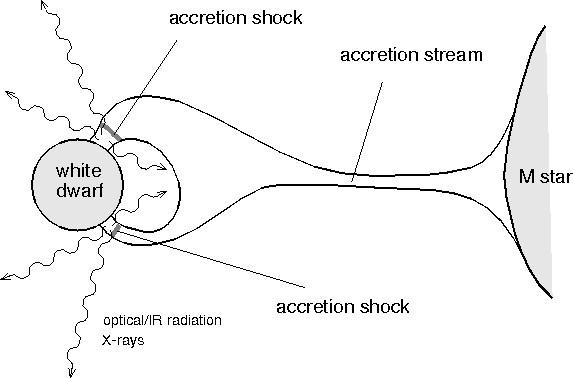Determining white dwarf masses from X-ray spectra




Next: Other activities
Up: Research highlights
Previous: Gamma-ray pulsars with
The masses of white dwarf stars can be determined from their X-ray emission,
but this can give misleading results if the white dwarf has a strong magnetic
field.
Kinwah Wu and his collaborators have devised a simple means of
overcoming this problem.
A `cataclysmic variable' (CV) is a binary star system consisting of a
white dwarf
and an ordinary star which is only one fifth to one half the mass of the Sun.
In a rotating binary system there is an enclosed region around each star,
called the Roche lobe, within which matter is gravitationally bound to the star.
The sizes of the Roche lobes depend on the separation between the stars;
stars that are close together have small Roche lobes.
In CVs the separation between the stars is so small that the companion star
fills its Roche lobe, and matter spills over onto the white dwarf, so that
the white dwarf is said to `accrete' matter from its companion.
The accreting material has to decelerate from a supersonic to a subsonic speed
before settling onto the white dwarf surface,
and a shock is generally formed where this transition occurs.
The shock heats up the accreting gas to a temperature
of typically  K (one hundred million degrees).
The temperature attained at the shock determines much of what happens
in the hot post-shock region, including what emission processes cool the gas.
X-rays have been observed from accreting white dwarfs and the shape
of X-ray spectra are characteristic of the temperature of the
emission region.
The X-rays are believed to be emitted by the hot gas downstream of
the accretion shock, and the temperature of this gas depends on
the white dwarf mass.
The mass of accreting white dwarfs can therefore be
deduced from observations of this X-ray emission.
K (one hundred million degrees).
The temperature attained at the shock determines much of what happens
in the hot post-shock region, including what emission processes cool the gas.
X-rays have been observed from accreting white dwarfs and the shape
of X-ray spectra are characteristic of the temperature of the
emission region.
The X-rays are believed to be emitted by the hot gas downstream of
the accretion shock, and the temperature of this gas depends on
the white dwarf mass.
The mass of accreting white dwarfs can therefore be
deduced from observations of this X-ray emission.
For CV systems which contain a white dwarf with a strong magnetic field
an additional effect is important.
The shock-heated region is cooled not only via bremsstrahlung X-rays,
but also by cyclotron emission at optical and infrared wavelengths.
This additional cooling process means that the post-shock region is cooler
in magnetic CVs than in nonmagnetic CVs,
and this is manifest in the X-ray spectrum.
Thus using the X-ray spectra to determine the white dwarf masses
in these systems,
without correcting for the effects due to cyclotron cooling,
may lead to a severe underestimate of the white dwarf mass.

Figure: A schematic of the shock region that forms in an accretion column near the surface of the white dwarf in magnetic cataclysmic variable systems.
To correctly determine the white dwarf mass the temperature and density
structure of the shock-heated region must be calculated.
This is a complicated process when cyclotron radiation is involved as the
shock is `optically thick' to this type of emission -
those optical and infrared photons emitted deep inside the shock-heated
region are absorbed by the surrounding material before they can escape.
Thus only photons emitted at or near the surface can escape to be observed.
This makes it hard to use the available observational data to determine
the temperature and density structure of the shock-heated region,
and large, complicated numerical calculations are usually necessary.
Prof. Ganesar Chanmugam (LSU), Prof. Giora Shaviv (Technion)
and Kinwah Wu have found a simpler, but still effective,
way of calculating white dwarf masses from X-ray spectra
by using a semi-analytic method to determine the structure of the
post-shock region.
They construct an effective composite cooling function that mimics both
cyclotron and bremsstrahlung cooling,
and with this cooling function have found closed form solutions
for the hydrodynamic equations.
This allows the temperature and density structures of the shock-heated regions
to be calculated, and a model X-ray spectrum to be generated
which can then be fitted to the data.
The results from the semi-analytic formulation agree very well with
the sophisticated numerical calculations, but are far simpler to derive.
This technique therefore provides a simple and effective means of determining
the mass of accreting magnetic white dwarfs.




Next: Other activities
Up: Research highlights
Previous: Gamma-ray pulsars with
Stephen Hardy / stephen@physics.usyd.edu.au
 K (one hundred million degrees).
The temperature attained at the shock determines much of what happens
in the hot post-shock region, including what emission processes cool the gas.
X-rays have been observed from accreting white dwarfs and the shape
of X-ray spectra are characteristic of the temperature of the
emission region.
The X-rays are believed to be emitted by the hot gas downstream of
the accretion shock, and the temperature of this gas depends on
the white dwarf mass.
The mass of accreting white dwarfs can therefore be
deduced from observations of this X-ray emission.
K (one hundred million degrees).
The temperature attained at the shock determines much of what happens
in the hot post-shock region, including what emission processes cool the gas.
X-rays have been observed from accreting white dwarfs and the shape
of X-ray spectra are characteristic of the temperature of the
emission region.
The X-rays are believed to be emitted by the hot gas downstream of
the accretion shock, and the temperature of this gas depends on
the white dwarf mass.
The mass of accreting white dwarfs can therefore be
deduced from observations of this X-ray emission.
